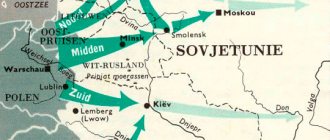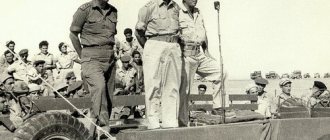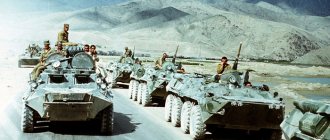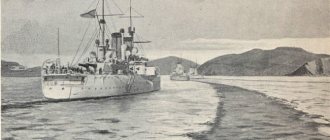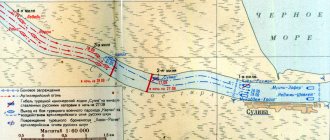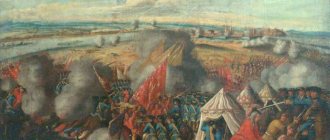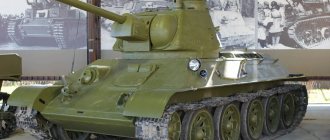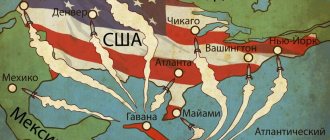The Russian-Turkish War of 1877-1878 took place in the lands of the Balkan Peninsula and the Caucasus at the beginning of the last third of the 19th century. The confrontation unfolded between the Russian and Ottoman empires. Accordingly, the war was named after these main forces and the time of the event.
On the side of Russia were the peoples of the Balkans oppressed by the Ottomans, and the Ottoman Empire was supported by almost all (with the exception of Germany) European countries that did not want the strengthening of Russia or were simply following Britain’s lead.
The war lasted almost a year and ended with the complete defeat of the Ottoman forces. As a result, at the negotiations held first in San Stefano and later in Berlin, Serbia, Montenegro and Romania gained independence, and Bulgaria gained autonomy. This opened the way to the complete liberation of the Slavic peoples of the Balkans from Ottoman oppression.
Goals of the parties
Russia's main goals in the war were:
- Denunciation of all provisions of the Treaty of Paris, which deprived Russia of the right to have a fleet in the Black Sea and deprived it of the opportunity to pursue an independent policy in the Transcaucasus, the Balkans and the Middle East
- Protection of Christians living in the territory of the Ottoman Empire from regular persecution and direct physical extermination
- Assistance in continuing liberation from the Ottoman yoke to the Slavic peoples of the Balkan Peninsula
In turn, the Ottoman Empire sought to:
- Preserve the attitude towards Russia that was formed after the Crimean War, as a geopolitical subject that is incomplete and in need of control by European powers.
- It sought to maintain the support of both Britain and France, and positioned itself as a counterweight to Russia in the region.
- She positioned herself as a defender of the interests of the Muslim population of the Caucasus, as a supporter of their separatist aspirations.
Balance of power
The Russian Empire and its allies deployed about 500 thousand soldiers on the Balkan front. The artillery had at least 690 guns of various calibers.
In the Caucasian theater of military operations, Russia deployed approximately 150 thousand soldiers from its total number of troops.
The Ottoman Empire had about 300 thousand regular soldiers. Turkey's artillery had about 300 field-type guns and at least the same number of fortress systems.
In addition to the regular forces, numerous irregular units acted on the side of the Ottoman army, in particular, the bashi-bazouks, notorious for their atrocities against the defenseless population. This also included detachments of Abkhaz, Chechen and Dagestan rebels.
The Turks had small arms and some artillery of the latest systems (British, French and American production). The soldiers of Russia and its allies had slightly worse weapons. But the Ottoman army was characterized by low combat training and moral decay. Its soldiers were prone to pogroms and reprisals against their own population (mostly Christians). The personnel of the Russian army and Slavic militias received enormous moral support from the population of the Balkans, who welcomed them as liberators.
Army reform helped achieve victory
This war became a serious test for the Russian army, which was formed for the first time on the basis of universal conscription. Thanks to the military reform of General Dmitry Milyutin, carried out in the 60-70s of the 19th century, it was possible to reduce the size of the army by 40% in peacetime and at the same time obtain well-prepared military reserves in case of war.
By the beginning of the military campaign, there were more than a million people under arms, which made it possible during the war to quickly form and transfer fresh units to the active army.
During the reform, the General Headquarters was created and division into military districts was introduced, which seriously improved the command and control of troops. And the network of cadet schools, where representatives of all classes were accepted, qualitatively improved the training of officer personnel - the weak point of the Russian army since Nicholas times.
The infantry was rearmed: smooth-bore rifles were replaced by rifled rifles of the Krnka and Berdan systems, which were much lighter, loaded faster and allowed shooting at a greater distance.
All this allowed the Russian army to conduct offensive battles on two fronts at once - the Balkan and Transcaucasian, maintaining the strategic initiative from the first to the last days of the campaign.
Commanders and military leaders
The Russian side took part in the planning and conduct of the campaign of 1877-78:
| N.N. Obruchev | The author of the war plan played a big role in convincing the emperor of the need for this war itself. Due to hostile attitude led. book Nikolai Nikolaevich was sent to the Caucasus. Here he became the developer of the operation to break through the Turkish front and capture the Kars fortress. This victory became key to the defeat of the Ottoman troops in this direction. |
| Grand Duke Nikolai Nikolaevich | The commander-in-chief of the active army, personally led the crossing of Russian troops across the Danube, and later the final assault on Plevna. On behalf of the Russian emperor he concluded a truce at the end of the war. He believed that it was necessary to occupy Constantinople despite threats from Britain. He received a direct ban on this from his reigning brother. |
| Tsarevich Alexander Alexandrovich | Headed the Guards Corps |
| I.S. Ganetsky (later replaced by M.N. Dokhturov) | He commanded the grenadier corps, was a real military general, was distinguished by his care for the soldiers and enjoyed enormous authority among them. It was he who led the troops that prevented the breakthrough of the Ottoman troops from Plevna. And he accepted the surrender of this fortress. |
| K.I. Gershelman (replaced by V.N. Salov) | He headed the 1st Army Corps and was responsible for significant sanitary losses near Shipka. He was distinguished by his careerism and indifferent attitude towards the rank and file. |
| P.D. Zotov | He commanded the 4th Army Corps and led the headquarters for the siege of Plevna. For all his honesty and diligence, he showed indecisiveness and timidity at crucial moments. It was he who led the unsuccessful assault on the fortress. |
| F. F. Radetsky | He headed the 8th Army Corps and showed himself excellently in battle as a commander and officer. He was distinguished by personal courage. At decisive moments he led the attacking formations of his soldiers. It is he who is credited with holding the Shipka Pass and the subsequent destruction of the Ottoman army blocking it. |
| N.P. Kridener (he was replaced by L.A. Tatishchev, V.K. Svechin, A.I. Shakhovskoy) | He commanded the 9th Army Corps and took the Nikopol fortress by storm. Participated in the defense of Shipka and the subsequent raid across the southern Balkans. |
| A.I. Shakhovskaya | He headed the 11th Army Corps and took charge of it before the start of the war. He commanded the entrusted unit as part of the Lower Danube group of troops. |
| P.S. Vannovsky | He managed the 12th Army Corps, commanded first the headquarters, and then the entire Rushchuk detachment. He was distinguished by his diligence and discipline. Subsequently, he was appointed by the emperor to the positions of Minister of War and Minister of Education. |
| A.F. Gan (was replaced by Lieutenant General Yu.I. Schilder-Schuldner and K.N. Manzei) | He commanded the 13th Army Corps and had a reputation as an experienced combat officer from the events of the Sevastopol defense. He confirmed this with his command of the unit entrusted to him in the new war. |
| A.E. Zimmerman | He headed the 14th Army Corps and was an experienced combat officer. He distinguished himself in companies in the Caucasus and Central Asia. His unit was the first to cross the Danube and ensure the safety of the left flank of the Russian troops. Subsequently, he conducted successful offensive operations and liberated the city of Dobrich. |
| N.G. Stoletov (he was replaced by F.V. Davydov) | Commanded the Bulgarian militias. From scratch he created thousands of militia detachments. At their head he participated in the defense of Shipka, after which he was among the advancing Russian troops and distinguished himself in the battles for Sheinovo. |
Russian-Turkish War 1877-1878 Peace of San Stefano.
Emperor Alexander II and Gorchakov 1871
The second half of the 19th century is associated with a further aggravation of the Balkan crisis. In 1875, a powerful anti-Turkish uprising broke out in Bosnia and Herzegovina. In April 1876, an uprising began in Bulgaria , which was brutally suppressed by the Turkish authorities. The further development of the national liberation movement of the Balkan peoples raised before the European powers the question of both the future fate of the Ottoman Empire and the future fate of the South Slavic peoples .
Russia, defeated in the Crimean War of 1853-1856, sought to strengthen its international authority by strengthening its influence on the strategically advantageous Balkan Peninsula. Russian society expressed sympathy and sympathy for the rebellious Balkan peoples, demanding that the government help the “brother Slavs.” “Slavic committees” began to be organized in Russia, collecting donations in favor of the struggling southern Slavs; many Russian volunteers were sent to the Balkans among whom were the writer G.I. Uspensky, artists V.D. Polenov and E.K. Makovsky, famous doctor S.P. Botkin .
Emperor Alexander II did not want another war with Turkey. The rearmament of the Russian army was not completed, and the financial situation in the country was also difficult. The internal political situation in Russia was also turbulent - a populist revolutionary movement . That is why, at the initial stage of the crisis, the Russian government tried to solve the problem through diplomatic means, using its allies - Austria-Hungary and Germany.
In May 1876, Russia, Austria-Hungary and Germany signed the Berlin Memorandum , in which these states agreed to put pressure on the Ottoman Empire to encourage it to initiate reforms in the Balkans . France and Italy joined this memorandum England, wanting to maintain its influence in the Ottoman Empire, refused to accede to this document. Turkey's suppression of the uprising in Bulgaria and the intervention of the Great Powers in the Balkan crisis led to its further strengthening.
In June 1876, Serbia and Montenegro declared war on the Ottoman Empire. Russian general M.G. Chernyaev, who came voluntarily to Serbia, became the commander-in-chief of the Serbian army . The Serbian-Montenegrin army was quickly defeated , and Alexander II was forced to take more active action. The Russian government sent an ultimatum to the Ottoman Empire , in which it demanded that the Ottoman government immediately conclude a truce with Serbia, threatening to start a war otherwise. The Turkish Sultan was forced to accept Russian conditions.
Meetings of European delegations were held in Constantinople to develop the terms of an agreement with the Ottoman Empire. In 1876, the Turkish Sultan Abdul Hamid II promulgated a constitution that established the equality of all citizens - Muslims and Christians before the law. Negotiations in Constantinople continued for another month, but the Turkish Sultan rejected the proposal of the European powers to grant internal autonomy rights to Bulgaria, Bosnia and Herzegovina. The Eastern crisis has entered its final phase.
In the fall of 1876, Emperor Alexander II began mobilizing the Russian army. At the same time, diplomatic preparations for war continued, the task of which was to ensure the benevolent neutrality of Austria-Hungary . On January 3 (15), 1877, in Budapest, Russia concluded a secret agreement on benevolent neutrality with Austria-Hungary. The Austrian government pledged not only to maintain neutrality towards Russia, but also to prevent other powers from interfering in the Russian-Turkish conflict. In return, the Austrian cabinet reserved the right to occupy Bosnia and Herzegovina. At the same time, the Russian government did not give up hope of resolving the crisis peacefully.
On March 19 (31), 1877 in London , representatives of Russia, Great Britain, Austria-Hungary, Germany, France and Italy signed a protocol containing a demand for the Turkish Sultan Abdul Hamid II to carry out reforms based on the decisions of the Constantinople Conference. The Ottoman government rejected these demands, considering them an interference in its internal affairs. Preparations for war began.
On April 4 (16), 1877, an agreement was signed between Russia and Romania, according to which Russian troops could use railways, postal and telegraph communications on the territory of Romania. Romania pledged to assist in providing the Russian army with food and fodder (French fourrage “feed”). Russia acted as a guarantor of preserving the integrity of the Romanian principality and pledged to reimburse all costs of supplying its army. On April 12 (24), 1877, the Russian emperor signed a manifesto on the beginning of the war with the Ottoman Empire.
FROM THE MEMORIES OF V.P. MESHCHERSKY
Grandson of the famous historian and writer N.M. Karamzina V.P. Meshchersky is a talented writer and publicist, publisher of the magazine “Citizen”, in his notes he reflected the mood of Russian society in relation to the rebel Bulgarians and the activities of the Slavic Committee. “For people who doubt that the movement of minds in favor of the Slavs is truly popular, I would advise them to read at least a particle of the letters received by I.S. Aksakov as the chairman of the Slavic committee from different parts and from different persons in Russia. It is in Moscow, the center of Russian life, that this sympathy in the form in which it manifests itself is possible. A merchant writes from his shop at the Nizhny Novgorod fair: “When, for God’s sake, will we stand up for our brothers stronger and more effectively.” There, another merchant writes from the wilderness of Siberia: “Isn’t it possible for all loyal subjects to tell the tsar that we are ready to go to the last for the faith, the tsar and the fatherland, wherever and against whom the tsar orders.” Here the priest of a distant parish writes: “I am sending money and the wishes of all parishioners so that the Lord will hear our prayers and lead us to deliver our brothers from oppression, grief and sadness.” Here the student writes: “I am sending what I can until I arrive in Serbia myself.” Here the officers of such and such a regiment write collectively: “There are many of us who want to fight for the liberation of the Slavs; maybe there will be a war; in the meantime, tell me, for God’s sake, can we go to Serbia at the expense of the Slavic Committee and what needs to be done? It’s a shame not to go.” And I.S. receives such letters. There are hundreds of Aksaks a day.”
EXARCH OF THE BULGARIAN CHURCH ANTIL - ALEXANDER II If His Majesty the All-Russian Emperor does not pay attention to the situation of the Bulgarians, does not protect them now , then it is better to cross them out from the list of Slavs and Orthodox Christians, for DESPAIR HAS TAKEN UP ALL!
FROM THE REPORT OF THE WAR MINISTRY During two partial mobilizations - November 1, 1876 and April 3, 1877, 27 infantry divisions, 4 rifle brigades, 9 cavalry divisions, a Don Cossack brigade, 3 sapper brigades and 1 grenadier division were formed . Thus, the Danube Army , intended for operations in the Balkan theater, consisted of seven corps : 4.8, 9, 11, 12, 13, and 14.
The brother of Alexander II, Grand Duke Nikolai Nikolaevich, was appointed commander-in-chief, and Adjutant General Nepokoichinsky . The main headquarters developed a “Schedule for the movement of troops of the Danube Army for concentration in Bessarabia.” It was planned to complete this event by January 1, that is, even before the second partial mobilization. And the Russian railways fulfilled this instruction, taking only one week beyond the announced period and transporting 254 thousand people , a large number of horses and cannons in just a month and a half.
WAR CORRESPONDENTS.
The huge public outcry that events in the Balkans caused in Russia could not but affect the actions of the ruling circles of St. Petersburg. , military correspondents were officially admitted into the active Russian army covering the course of military operations for their newspapers. In November 1876, at the request of the Minister of Internal Affairs A.E. Timashev, Vsevolod Krestovsky, the author arrived at the headquarters of the Russian army in Chisinau as a correspondent for the Government Bulletin . The largest staff of correspondents was the famous Russian publicist, publisher of the newspaper “Novoe Vremya” A.S. Suvorin , and the most popular Russian journalist was Vasily Ivanovich Nemirovich-Danchenko, who participated in all the main battles and was awarded for bravery the soldier’s Cross of St. George and the Order of St. Stanislaus, 3rd degree with swords.
Russian-Turkish War 1877-1878
BEGINNING OF MILITARY ACTIONS
On April 12, 1877, Russia declared war on Turkey. Emperor Alexander understood that the Balkan War would not provide material benefits and could drag on for a long time, but he still decided to take this step. The war was especially necessary to maintain the status of a great power and protector of the Slavic peoples.
The main events of the war took place on the Balkan Peninsula. The war began with the entry of the Russian army into the territory of Romania. The Russian armies, under the overall command of Grand Duke Nikolai Nikolaevich (the elder), entered the territory of Bulgaria, crossed the Danube with battles, meeting an enthusiastic reception from the Slavic population. After crossing the Danube, the Russian armies were divided into three parts: a detachment under the command of General Gurko was supposed to cross the Balkan ridge and go behind the rear of the Turkish army in the area of Adrianople. General Kridner's detachment was supposed to occupy Plevna and Nikopol. A detachment under the command of the heir to the Russian throne, Grand Duke Alexander Alexandrovich, was supposed to occupy Rushchuk . The Bulgarian militia , commanded by the Russian general N.G. also operated as part of the Russian troops. Stoletov.
“WINTER SEAT” ON SHIPKA
Fulfilling the plans of the Russian command, Gurko’s detachment captured the ancient Bulgarian capital of Tarnovo. The Russian army faced a difficult transition through the Balkan Mountains. In June 1877, Russian troops reached Shipka , an important and well-fortified pass. The Turkish armies, fearing encirclement, left this pass. Gurko's army crossed into the territory of Southern Bulgaria, however, having met the large army of Suleiman Pasha there, they were forced to retreat back to the pass.
At the beginning of August 1877, the famous six-day Battle of Shipka began . Having fired all the cartridges, the few heroic defenders of the Eagle's Nest repelled the attacks of the superior Turks with stones and rifle butts. The situation was saved by the arriving army units under the command of Radetsky and Dragomirov. Suleiman Asha was forced to retreat. One of the most heroic episodes of this war began - the defense of Shipka from the superior forces of the Turkish army . Bulgarian militias also took part in this defense After several unsuccessful assaults by the Turkish army, the winter “sitting” began on Shipka , where Russian soldiers and Bulgarian militias showed unprecedented courage and perseverance. The defense of the pass blocked the Turks from entering Northern Bulgaria and was key to the successful completion of the war. Personnel losses during the “winter sitting” on Shipka ranged from 40 to 60%, but the Turkish army never managed to penetrate northern Bulgaria.
SIEGE OF PLEVNA
In the summer of 1877, simultaneously with the battle for Shipka, for the fortress of Plevna, one of the most important strategic points, unfolded The routes from Rushchuk, Sistov, Sofia converged here; From here there was a path to the Shipka Pass. In these battles, the troops under the command of the talented military leader M.D. Skobelev, a man of great personal courage. However, three assaults on the Plevna fortress ended in failure . assault on Plevna on August 30-31, 1877, which was preceded by intensive four-day artillery preparation, was especially bloody Despite the fact that at the cost of huge losses, the Russian units managed to capture the Turkish redoubts in front of Plevna , due to the mistakes of the command and General P.D. Zotov , who never brought the main forces of the Russian army into battle, they were knocked out of there.
General P.D. Zotov never decided to bring the main forces into battle, even despite the fact that the “keys of Plevna” - the redoubts Abdul Bey and Rezhdi Bey were taken by Russian soldiers under the command of General Skobelev , who personally, on a white horse, led the regiments into the attack . 22 Russian battalions fought with superior enemy forces in front of 84 Russian battalions , which, due to Zotov’s indecisiveness, never entered the battle.
A battalion of the Vladimir regiment, under the command of Major Gortalov, was left at the Abdul Bey redoubt . General Skobelev made him promise not to retreat from the redoubt under any circumstances. The next day, Turkish troops furiously attacked the redoubt of Major Fedor Gortalov in large forces in order to recapture their lost positions. of the Vladimir regiment who remained in their positions steadfastly against the entire Turkish army - the forces were clearly unequal . When the impossibility of continuing the assault became obvious, General Skobelev sent an order to retreat to Gortalov, saying at the same time that he was releasing him from his obligations. “Tell General Skobelev that only death can free a Russian officer from his word,” replied Major Gortalov. Having released the surviving soldiers of the regiment, Major Gortalov returned to the redoubt and, with his saber drawn, rose to meet the attacking Turks...
The losses of Russian troops amounted to about 13 thousand people, while the Turks lost about 3,000 people.
Skobelev was indignant: “Napoleon was happy if one of the marshals won him half an hour of time. I won a whole day with it - and they didn’t take advantage of it!”
Alexander II near Plevna. Russian-Turkish War 1877 - 1878
The siege of the Plevna fortress began, the leadership of which was entrusted to E.I. Totleben - hero of the Sevastopol defense of 1854–1855. In early December 1877 , having exhausted food supplies, the Turkish army under the command of Osman Pasha surrendered.
The capture of Plevna was a turning point in the course of the war . At the beginning of 1878, the path to Southern Bulgaria was opened for Russian troops. In winter, almost impassable mountain passes were overcome. The Russian army moved towards Sofia, the Russian armies took Adrianople. The outcome of the war was a foregone conclusion. The famous German Field Marshal Moltke, having learned about the fall of Plevna, hid the map on which he followed the progress of military operations in the Balkans, saying: “Until next year!”
MEMORIES OF N.P. IGNATIEVA
The famous Russian diplomat N.P. Ignatiev, the Peace of San Stefano on behalf of Russia , left interesting notes on the course of military operations. Here, for example, is how he described the surrender of Plevna and the commander of the Turkish army, Osman Pasha :
"Hooray! Osman with his entire army surrenders unconditionally, reprimanding only that the property of the Turkish officers be left to them (a feature of military morals is the only concern of the commander-in-chief) <...> Osman bravely attacked the grenadier company all morning, was wounded in the arm and finally ceased fire, having made sure that it is impossible to break through. The Volyn and Lithuanian regiments captured three Turkish redoubts from battle and took 3 thousand prisoners with the pasha. Osman sent his adjutant to Ganetsky to say that he was ill and asked to send a general to him. He was told that he should send another pasha in his place. <….> In general, all the Turks, especially the officers, were sad and looked bitterly at our people. Indeed, it is difficult even for us to look at people who have performed their duty bravely and selflessly and are faced with the sad necessity of laying down their arms. Here the royal face lit up. The Emperor took off his cap and shouted with us, crossing himself, “Hurray!” Everyone congratulated each other, as if on a bright holiday. The Cossacks, the convoy, the coachmen, the court servants - everyone shouted “Hurray!” <….> After breakfast, Osman was brought to the sovereign. He was wounded in the left leg below the knee while his horse was killed under him. Everyone liked his smart and interesting, energetic and emaciated face. He was small in stature and entered modestly, leaning with both hands on the shoulder of his adjutant and orderly, the commander-in-chief, Prince B. (the latter hacked three Turks with his own hands and is known for his strength), since he could only walk on one leg. His wound was open and only bandaged, there was a shoe instead of a boot, and his pants were cut. He said that he had from 27 to 28 thousand in the ranks in the last case, that he tried to break through, although he knew it was hopeless, but to satisfy military honor to the end. The Emperor returned the saber to him. When Osman passed through the courtyard filled with our and Romanian officers, everyone bowed to him, crowding and rushing to take a closer look. Suddenly someone shouted: “Osman, bravo!”, and our people began to repeat and even applaud. This tactless manifestation puzzled Osman, but then he began to smile pleasantly at the individuals who applauded under his breath!”
Russian-Turkish War 1877-1878 in Transcaucasia
MILITARY ACTIONS IN THE TRANSCAUCASUS
The command of the Russian troops in the Caucasian theater of military operations was actually carried out by M.T. Loris-Melikov. Formally, the commander was considered Mikhail Nikolaevich, the youngest son of Nicholas I. In May 1877, Russian troops captured the Bayazet and Ardagan fortresses, and in November 1877, after a stubborn battle in the Aladzhin Heights area, the key Turkish fortress of Kars fell. After this, the Russian army reached Erzurum.
The fortified city of Erzurum was occupied by the detachment of General Vasily Geiman in 1878, at the end of the next Russian-Turkish war. The first assault on Erzurum ended unsuccessfully. The siege proceeded sluggishly, but the Russians again occupied the Erzurum fortress on February 19, 1878, not exactly without a fight, but close to it. According to the San Stefano Peace Treaty, the Turks had to leave the city of Erzurum.
The Erzurum fortress, already well protected by natural barriers, with the help of German engineers, by the beginning of the First World War in 1914, turned into a virtually impregnable fortified bastion.
One of the heroic pages of military operations in the Caucasus was the defense of Bayazet by Russian troops in June 1877 from superior enemy forces under the command of Faik Pasha . At the very beginning of the war, on April 18 (30), 1877, the Erivan detachment of the Russian army under the command of Lieutenant General Tergukasov occupied Bayazet without a fight. Leaving a small garrison in the Bayazet fortress, on April 26 (May 8), the Erivan detachment continued its attack on Erzurum deep into Turkish territory. The small garrison of the Bayazet fortress steadfastly repelled enemy attacks. The Turkish command planned, having destroyed the Russian garrison mercenary troops to the Erivan province, which at that time remained unprotected, mostly consisting of Kurdish militias “... animated by the spirit of robbery”
.
Liberation of the garrison of the Bayazet citadel in 1877. Hood. L. F. Lagorio (1885)
There was no food or water in the Bayazet citadel, and the commandant of the fortress, Lieutenant Colonel Patsevich , offered to surrender at a military council, but was shot by his own officers, who decided to resist to the end. The Russian garrison of the Bayazet fortress under the command of Captain Shtokvich, repelling the assault and despite hunger and thirst, refusing to capitulate, continued to hold the defense of the Bayazet citadel for 23 days, until the Erivan detachment came to its aid.
General Tergukasov
The garrison of the fortress was saved on the 24th day of the siege by General Tergukasov, who defeated the troops of Faik Pasha.
Outnumbered Turkish troops were defeated in the Caucasus. In order to prevent Turkey from having time to unite with England and Austria-Hungary, it was decided to continue the offensive in the winter. At the same time, part of the troops reached Istanbul and occupied its suburbs.
Surrender of Turkish troops in Erzurum
Emperor Alexander was afraid of interference from other countries in the Russian-Turkish War, so he categorically ordered General M.D. Skobelev not to take the Turkish capital.
The signing of the San Stefano Peace Treaty on February 19 (March 3), 1878 between the Russian Empire and the Ottoman Turkish Empire ended the Russian-Turkish War of 1877-1878 .
The result of the Russian-Turkish War of 1877-78 on the Balkan Peninsula was the liberation of the Balkan peoples from centuries-old Ottoman rule. The Peace of San Stefano was of great importance for the liberation of the Balkan peoples from the Ottoman Empire.
SAN STEFAN WORLD
On February 19 (March 3), 1878, a peace treaty was signed 12 kilometers from Constantinople, in the town of San Stefano According to the articles of the Peace of San Stefano
1. Serbia and Montenegro were declared completely independent states. 2. Bulgaria became an autonomous principality. 3. Bosnia and Herzegovina received autonomy. Part of Bessarabia , torn from it in 1856 after the Crimean War, returned to Russia 5. In the Caucasus, of Ardagan, Batum, Bayazet, and Kars were added to Russian possessions 6. The Ottoman Empire had to pay 310 million rubles in indemnity.
The day of the signing of the San Stefano Peace Treaty is a national holiday in Bulgaria.
BERLIN CONGRESS
Naturally, the Western powers, not wanting to allow such a strengthening of Russia, came out with a sharp protest against the conditions of the San Stefano Peace. In February 1878, the British squadron entered the Sea of Marmara , and Austria-Hungary began military preparations. The Russian government, fearing the continuation of the war with new opponents, was forced to agree to a peace conference to revise the terms of the Peace of San Stefano, which opened in the summer of 1878 in Berlin under the chairmanship of Otto Bismarck. Under pressure from England and Austria, Russia was forced to make a number of significant concessions.
Signed on
July 1 (13), 1878, the Berlin Treaty provided for the following:
1. The autonomy of the Bulgarian Principality , but Bulgaria was divided into three parts : a vassal principality from the Danube to the Balkans with a center in Sofia ; Bulgarian lands south of the Balkans formed an autonomous province of the Turkish Empire - Eastern Rumelia, with its center in Philippopolis under the control of a governor-general appointed by the Turkish Sultan from the Slavs. Macedonia - lands up to the Adriatic and Aegean Sea were returned to Turkey without any changes in status. 2. Austria-Hungary received the right to occupy the territory of Bosnia and Herzegovina, and Great Britain occupied the island of Cyprus , subsequently turning it into a naval base. 3. The independence of Serbia, Montenegro and Romania , while the territories of Serbia and Montenegro were increased. 4. Russia retained the mouth of the Danube , and the fortresses of Ardahan, Kars and Batum in the Caucasus 5. The indemnity was confirmed in the previous amount.
After the Berlin Congress, the foreign policy activities of Emperor Alexander II took a new direction. As a result of the new treaty, Russia lost a significant part of the advantages it had acquired under the Treaty of San Stefano, while the Austrian Empire, which did not take part in the war, occupied a position in the Balkan Peninsula at least equal to that of Russia. At that time, the already old chancellor A.M. Gorchakov said that the Berlin Congress was “the darkest page of my career,” and Alexander II noted that “Mr. von Bismarck forgot his obligations given in 1870.”
Thus, the decisions of the Berlin Congress became the source of new, no less acute conflicts in the Balkans at the end of the 19th and beginning of the 20th centuries. However, the Balkan War occupies a special place among the numerous Russian-Turkish conflicts . It was thanks to her that the liberation of the Balkan peoples from centuries-old Turkish rule took place. This war was of particular importance for the Bulgarian people, who for the first time received autonomy rights. As a memory of that war, there are majestic monuments in Moscow and Sofia, on Shipka and Plevna, streets, squares and boulevards of Russian and Bulgarian cities are named after its heroes.
IN MEMORY OF THE WAR OF 1877-1878
In memory of the war of 1877-1878. a medal was established, made from three different metals according to the degree of participation in this war. On its front side there was an image of a Christian cross trampling the Islamic crescent and the dates 1877-1878. The most honorable was the silver one, which was awarded to participants in the defense of Shipka, the Bayazet fortress and the assault on the Kars fortress. A light bronze medal was issued to everyone who took part in hostilities, and a dark bronze medal was issued to war participants who did not take part in battles. This medal was awarded to all military personnel, regardless of rank and branch of service, as well as Bulgarian militias.
Literature:
Russian-Turkish War 1877-1878 M., 1977 Vinogradov V.I.
Russian-Turkish War 1877-1878 and the liberation of Bulgaria. M., 1978 Zolotarev V.A. Russian-Turkish War 1877-1818 vols. in domestic historiography of the late XIX - early XX centuries. M., 1978
Ivanov R.N. Defense of Bayazet: truth and lies. Documentary story. M., 2005
Collection of materials on the Russian-Turkish war of 1877-78. on the Balkan Peninsula. Vol. 1-97. St. Petersburg, 1900-1911
Collection of materials on the Russian-Turkish war of 1877-78. at the Caucasus-Asia Minor Theater. Vol. 1-4. St. Petersburg, 1903
Description of the Russian-Turkish war of 1877-78. on the Balkan Peninsula. St. Petersburg, 1901 -1913
San Stefano Preliminary Peace Treaty Troitsky N. Russian-Turkish War of 1877-1878: Results
The assault and capture of Erzurum in 1916 by General Yudenich
Russian-Turkish War of 1806 - 1812.
Main stages
Military operations took place in two theaters - the Balkan proper and the Caucasus. In the Balkans, all military operations can be represented in the form of four stages:
- April-July 1877 - Russian troops crossed the Danube and occupied the surrounding areas.
- July 1877 - 1st transition of Russian troops through the Balkans. Active advance of Russian troops and their allies across the northern Balkans. An attempt to cross the Balkan ridge.
- August-December 1877 - siege of the Plevna fortress and defense of the Shipka Pass. Accumulation of Russian troops to cross the ridge and break through to Istanbul
- Late December 1877 - early January 1878 - 2nd crossing of the Balkan Mountains. The defeat of the main Ottoman forces, which did not allow passage through the mountains. Breakthrough to the suburbs of the Ottoman capital and the defeat of the last capable Ottoman military units.
The Caucasian theater was considered auxiliary by Russia. The Russian troops had two goals here:
- Diverting enemy forces from the Balkan direction,
- Protecting your own territories from attempts to destabilize or invade.
Turkey, accordingly, tried to divert as many Russian troops as possible here, to cause riots and uprisings in the territory of Abkhazia, Chechnya and Dagestan.
Events unfolded as follows:
- May - August 1877 - Ottoman landing near Sukhum and rebellion in Abkhazia, inspired by Ottoman emissaries. The result of indecisiveness in eliminating these events was the uprising in Chechnya and Dagestan. Which distracted a certain number of Russian forces.
- April 1877 - February 1878 - a series of battles in Transcaucasia. The capture by Russian troops of the fortresses of Bayazet, Ardahan, Kars, Erzurum. Destruction or capture of all Ottoman armed units present in the region (Bayazet seat, Avliyar-Aladzhin battle).
Fighting on the Danube
Victory over Turkey was impossible without crossing the Danube. The Turks were well aware of the importance of the Danube as a natural barrier for the Russian army, so from the beginning of the 60s they began to create a strong river flotilla and modernize the Danube fortresses - the most powerful of them were five. The commander of the Turkish flotilla was Hussein Pasha. Without the destruction or at least neutralization of the Turkish flotilla, there was nothing to think about crossing the Danube. The Russian command decided to do this with the help of barrage mines, boats with pole and towed mines and heavy artillery. Heavy artillery was supposed to suppress enemy artillery and destroy Turkish fortresses. Preparations for this began in the fall of 1876. Since November 1876, 14 steam boats and 20 rowing ships were delivered to Chisinau by land. The war in this region was long and protracted, and only by the beginning of 1878 most of the Danube region was cleared of the Turks. They had only a few fortifications and fortresses isolated from each other.
Progress of the war (battle)
| 1877 | April 29 - May 14, 1877 | Destruction of the Ottoman flotilla on the Danube by Russian ships |
| 10 – 21 June | Crossing of the vanguard of Russian troops across the Danube (Battle of Sistov). An attempt by the Ottoman command to transfer its troops from Montenegro to disrupt the Russian offensive. | |
| 22nd of June | The beginning of the Russian offensive. Occupation of the cities of Byala and Tarnov. | |
| July 2 | Occupation of the Shipka Pass. | |
| 4th of July | Capture of the Nikopol fortress by Russian troops. | |
| July 8 | 1st battle of Plevna. | |
| July 18 | 2nd assault by Russian troops on Plevna. The transition of Russian troops to defense at the Shipka Pass. | |
| August 30 - 31 | 3rd attempt to capture Plevna. | |
| November 10 - 11, 1877 | An unsuccessful offensive attempt by Ottoman troops along the entire front. Russian troops inflict significant losses on the Ottomans and hold their positions. | |
| November 22 | The 25,000-strong Ottoman detachment defeats the 5,000-strong Eleninsky detachment of the 11th Russian corps. There was a danger of a Turkish breakthrough into the Russian rear. | |
| November 24 | Eliminating the danger of a breakthrough. Defeat of the Turks at Zlataritsa. | |
| November 28 | The starving Ottoman troops in Plevna tried to break out of the fortress, but were repulsed. After this, their commander surrendered the fortress to Russian troops. | |
| December 23 | Western detachment of General I.V. Romeiko-Gurko crosses the Balkan ridge and occupies Sofia. | |
| December 27 - 28 | The battle of Sheinovo, the destruction of the 30,000-strong Ottoman army. | |
| 1878 | January 3 – 5 | The battle of Philippopolis (Plovdiv), the destruction of the last organized force on the way to the Ottoman capital - the army under the command of Suleiman Pasha. |
| January 8 – 10 | Occupation of Adrianople by Russian troops. |
Peace treaty
On January 10, Russian troops occupy the city of Adrianople. The fall of Istanbul was a foregone conclusion. Therefore, the Sultan proposes concluding peace on terms beneficial to Russia. This treaty was signed on January 19, 1878.
But its conditions, which gave Russia advantages not only in the Black Sea region, but in the Balkans and in the waters of the Sea of Marmara, were unacceptable to Britain. Its ships were ready to begin bombing Russian troops if they attempted to approach Istanbul, and the emissaries incited the Muslim population of the Caucasus to revolt.
Since Britain began to organize a coalition of European countries along the lines of those opposing Russia in the Crimean War, Emperor Alexander II agreed to revise the treaty. On February 19, in the city of San Stefano (in fact, it was a suburb of Istanbul at that time), a new agreement was signed with the participation of British representatives.
According to its provisions:
- Russia was regaining the southern regions of Bessarabia lost in the Crimean War. The areas adjacent to the Caucasian cities and fortresses - Kars, Bayazet, Ardahan and Batum - also went to Russia.
- The Ottoman Empire paid significant sums of money as indemnities.
- The principalities of Serbia, Montenegro, and Romania received territorial increments and complete independence.
- Bulgaria received autonomy status and had to pay all possible tribute.
results
The final results of the war of 1877 - 78. were summed up at the Berlin Congress. It took place in the early summer of 1878. The result was the Berlin Treaty of July 1, 1878. The reason for this congress was Alexander's excessive compliance with Britain. The latter began to incite European powers against Russia, and even a number of forces in Serbia, Romania and Bulgaria took anti-Russian positions. The main provisions of the Berlin Treaty were:
- Significant reduction in the amount of indemnity that Turkey had to pay.
- International recognition of the occupation of Cyprus by Britain and Bosnia and Herzegovina by Austria-Hungary.
- Minimization of territorial increments for Serbia, Montenegro and Romania. But recognition of their independence.
- The division of Bulgaria into two parts - Southern and Northern. The first remained under the complete control of the Ottoman Empire.
Gratitude from the “brothers”
You said that this war is very important primarily for its consequences and that the memory of this war is very bizarre and specific in terms of its use to serve the national historical myth. What do you mean by this?
By historical myth I do not mean some kind of fiction, but a national version of past events. I talked about the further interpretation of this war by future historians. For Russia it truly became both victorious and liberating. As a result, our country overcame the difficult consequences of the unsuccessful Crimean War and restored its prestige in the world. But I meant the consequences for Russia’s relations with the liberated peoples.
This primarily concerns Bulgaria, which, after gaining independence, gained largely with Russian blood, headed for an alliance with Austria-Hungary and Germany. In 1886, Russia broke off diplomatic relations with it and things almost came to war. Typically, in both world wars of the 20th century, Bulgaria was on the side of the enemies of our country. The Serbian king Milan Obrenovic, after liberation from Turkish rule, also began to focus on Austria-Hungary, and in 1885 he started a war against Bulgaria.
Why did this happen?
I recently saw a publication in a Bulgarian newspaper from the 1890s. There is a phrase there, the meaning of which boils down to the fact that the Bulgarians have deep gratitude to the Russian hero-liberators, but distinguish between the fraternal Russian people and official Russia. Apparently, the ruling circles of the newly formed Balkan states were afraid of the excessive influence of St. Petersburg. No wonder the German dynasty established itself on the throne in Bulgaria.
Here the famous quotation from Dostoevsky immediately comes to mind that “Russia will not and never has had such haters, envious people, slanderers and even outright enemies as all these Slavic tribes, as soon as Russia liberates them, and Europe agrees to recognize them as liberated.” "
That's all true. Paradoxically, the more independent states were created on the territory of the former Ottoman possessions in Europe, the further Russia found itself from its cherished dream - Constantinople.
Why?
To advance on Constantinople during the Crimean War, Russian troops only needed to cross the border with the Ottoman Empire. By the beginning of the Russian-Turkish War of 1877-1878, instead of the two principalities of Wallachia and Moldavia controlled by the Turks, a single Romania already existed, with which it was necessary to negotiate in advance. After this war, a unified Bulgarian state also emerged.
Painting by Nikolai Dmitriev-Orenburgsky “Crossing of the Russian army across the Danube at Zimnitsa on June 15, 1877”
It is clear that in such conditions it was possible to forget about the capture of Constantinople by land, therefore all subsequent plans of the Russian General Staff to capture the Black Sea straits provided only for an amphibious landing. But this was a clear gamble, as clearly demonstrated by the unsuccessful Dardanelles operation of the British during the First World War.

